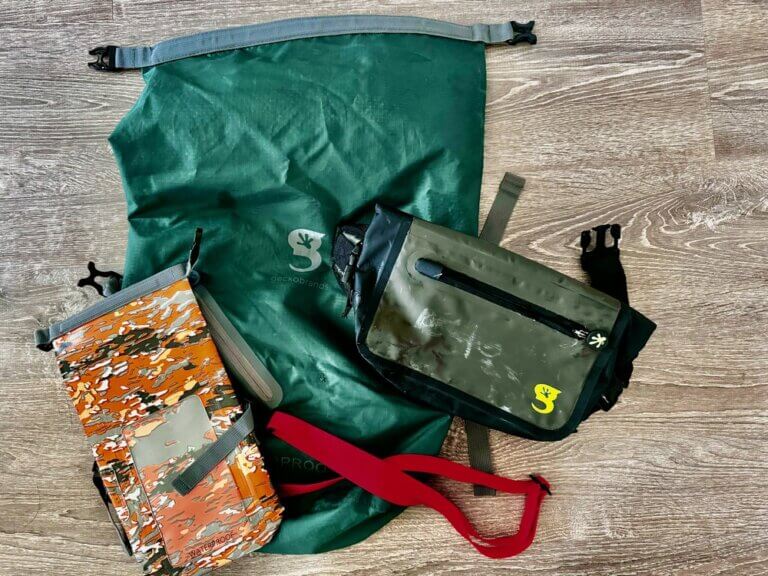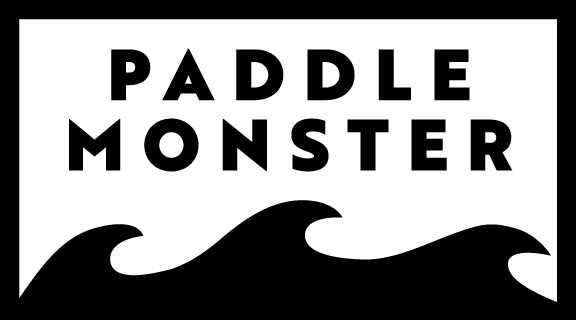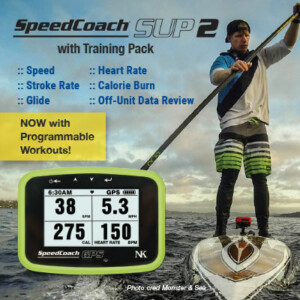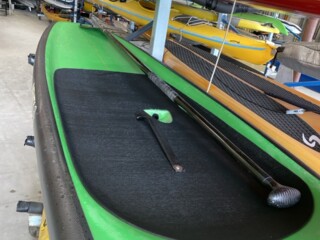
Strength Training Through the Competitive Season
Whether you’re a racer or serious fitness trainer, you’re probably pretty diligent about spending time in the gym building strength during the “off-season” when weather and lack of daylight hours make paddling more difficult and, often, less enjoyable.
I’ve made my thoughts pretty clear over the years on the value of strength training for paddle sports. Whether you’re paddling sprint canoe or kayak, outrigger, surf ski, dragon boat, or SUP, strength is a valuable part of the fitness package that you bring with you to the water. In fact, there are three pillars to paddling performance: technique, aerobic ability and strength.
Strength is particularly important for SUP paddlers. SUP boards are shorter, wider, and slower than canoes, kayaks, surf skis and outriggers meaning they have more resistance to movement through the water. This extra resistance makes strength even more important for SUP paddlers than other paddle athletes. Furthermore, since on a SUP you are standing, your bottom hand on the paddle is further from the water meaning you’ve got more paddle beneath your hand. This is mechanically disadvantageous compared to canoe, kayak or other sit-down paddle disciplines where your hand is closer to the load on the paddle blade. Think of your paddle as a long-handled garden spade. Try shoveling with your bottom hand close to the shovel blade. You can easily lift a fair amount. Now try moving your bottom hand closer to your top hand and away from the blade. It’s amazing how much this affects your ability to deal with load on the blade. You’re much, much weaker. Unfortunately, if you’re a SUP paddler, you can only get your bottom hand so close to the paddle blade. At some point you just can’t get it any lower. So, the only way to overcome this relative inefficiency is with strength. A stronger SUP athlete has a huge advantage over a weaker one.
Strength is obviously most easily and conveniently developed in the off-season when you aren’t able to paddle as much. Without having to increase your total training time, you can substitute time you would have spent on the water with a trip to the gym. I strongly recommend doing strength work three to four times a week throughout the off-season. Throughout my sprint canoe career, we did two “heavy” sessions and two “circuits” throughout the winter and were incredibly strong with amazing power endurance when we got back on the water in the spring.
If you’re one of those paddlers that spends time in the gym in the winter, you’ve no doubt felt the same thing – a high level of strength and strength endurance when you finally get back on the water. Even if you’re not on a particularly well-structured or planned program, just having gone to the gym and lifted throughout the winter is very likely going to leave you stronger in the spring than you were in the fall. For a SUP paddler in particular, this is a very good thing.
The question is, what should you do with regards to strength when you finally get back on the water?
The case for continued trips to the gym through the summer
If you’ve built a high level of strength and strength endurance through the winter, how long does that last through the paddling season? The answer is, it depends.
If you’ve got limited time to train and so just substitute your gym time for paddling once the temperatures rise and the rivers and lakes unfreeze the answer is not very long. Without lifting, over the course of a few months most people are going to lose a lot of the strength they’ve gained in the off-season. The good news is, you’re unlikely to end up being weaker in the summer than you were at the start of the off-season in the previous fall. The bad news is, all the work you put in in the winter to develop strength is going to be, eventually, lost. The question you need to ask yourself is, “do I want to let all that work go to waste”?
Don’t delude yourself into believing that paddling alone is going to maintain the strength you built. Don’t delude yourself into thinking that the strength you lose isn’t helpful or necessary in paddling if you don’t maintain it through paddling alone. Even if you paddle regularly into strong headwinds, put bungees around your board, or drag your leash for extra resistance, you’re going to eventually lose most of the strength you developed in the gym.
This strength loss is gradual, and therefore the effects of it are subtle and difficult to discern in your day to day paddling. But over time, you’re going to be a little less capable of really cranking dynamically against a hefty amount of water gathered and held on your blade. Over time, as your stroke becomes just a little less dynamic, you’re going to have to work a little harder but likely end up going a little slower. Imagine being able to bench press, for example, 100 lbs easily and explosively for 30 or more reps. Now imagine letting your strength slide by avoiding the gym for a few months. It’s not hard to imagine that it is going to be more difficult to crank out those reps with 100 lbs than it was before you stopped going to the gym. If you don’t maintain your strength through the summer, you’ll experience the same effect with the load you hold on your paddle each stroke.
I was reminded of this these last few months. During COVID, I avoided the gym for almost 2 years. My mother is in her 90s and I visit her almost every day. I didn’t want to stop seeing her as she relies on me to do stuff for her and I certainly didn’t want to give her COVID. So, I limited my exposure in every way I could which, unfortunately, meant I didn’t go to the gym. By Fall 2022 I felt the risk of returning to the gym had become acceptable, and I started to work out again. I loved it and didn’t realize how much I had missed it. I hammered, as hard as I used to when I was training sprint canoe, and watched my strength and, in particular, my power endurance rapidly return.
While away from the gym, I had no idea how my strength was declining and how it was impacting my paddling. Gradually losing strength is difficult to detect in your day to day paddling. It wasn’t until I’d been in the gym for a few months and had begun to build a good deal of my strength back that I really experienced the impact that strength has on paddling. I began to notice how much stronger I felt on the paddle and how much easier it was to sustain hard pulling.
The amazing thing is that things have just gotten better and better. As I’ve regained first some basic strength, then some power, then power endurance, I’ve reached the point where I am starting to develop some neuromuscular speed. I’ve also relearned to activate muscles that are useful in paddling but difficult to isolate and develop in paddling. The cool thing is that while deep core muscles and your glutes are difficult to really activate in the paddle stroke, they are pretty easy to activate and strengthen in the gym. I’ve realized that once you’ve learned how to activate them in the gym they are actually quite easy to activate in the stroke and can really make a difference, particularly in the second half of the pull and the exit.
At the moment, about six months after returning to the gym after my two-year COVID layoff, I feel stronger on the paddle than I can ever remember since I started paddling SUP. And I have better control of the muscles that I wanted to engage but wasn’t really able to engage well before. While I knew from my sprint canoe days how important strength work is to paddling, I’d never actually experienced the difference between having strength and not having it until now. It’s an incredible difference.
All of this begs the question, if you build strength in the gym in the off-season, why on earth would you want to neglect it and lose it in the summer? It is simply too important to neglect.
Strength work in the paddling season
If the off-season, or the part of the season when you’re not training for important races, is the time of year for strength development, then the paddling season (or competitive season) is the time for strength maintenance. You don’t need to spend as much time in the gym doing the same volume or intensity of strength work, but you do need to do enough gym work to maintain the strength that you’ve developed. This not only allows you to benefit from the fruits of your off-season strength training labor through the paddling season, it also allows you to start next off-season’s strength training with better strength abilities. In this way, your strength development work in each off-season can begin from a higher level and this allows you to build strength from year to year rather than simply trying to use each off-season to reacquire strength you’ve lost.
So, what should strength maintenance work look like? Well, I’d still advocate doing your strength work at least 2 to 3 times a week. However, I’d suggest a couple of additional things:
- Do your strength work after your paddling work. The summer paddling season, or competitive season if you are a racer, should see your on-water work as the priority. This means you want to do this work while your nervous system is fresh, not fatigued from doing work in the gym first. Do your paddling work first, then either do your strength work shortly after or later in the day. While you may not have quite the neuromuscular ability to devote to your lifting because of a little nervous system fatigue from paddling, you’re not trying to develop strength so much as maintain the strength that you developed in the off-season. You should be able to easily do this with whatever fatigue you might carry into the gym from your water workout. Try to lift on days when the on-water workload isn’t quite as high (either because it’s a lower intensity or shorter workout) as opposed to on days where the water work is really hard. And, make sure to take a day’s rest from strength work before doing the next strength session, just like you do in the winter. Gym sessions on Mondays, Wednesdays and Fridays after paddling, for example, is the perfect schedule.
- Don’t lift to failure. You don’t need to. Remember, you want to maintain the strength you’ve developed. You can do this and leave one or two reps in the tank.
- Address all the types of strength you trained in the off-season. You want to try to maintain your max strength as best you can, but you particularly want to maintain your power and power endurance. The best way to maintain all three abilities is to alternate what you work on from workout to workout. Use your day 1 to address max or sub max strength, use your day 2 to address power and your day 3 to address power endurance. Don’t worry about hypertrophy training, which is characterized by slow lifting that maximizes the time muscles are under tension. This work is designed to increase muscle size. You don’t want this, particularly during the paddling season, and you especially don’t want to be doing slow lifting when the work you’re doing on the water is designed to help you learn to move dynamically.
- Make your workouts shorter. You don’t need to spend as much time in the gym as you did in the winter. You can get away with doing fewer exercises each workout and/or fewer sets. I’d suggest that, if you are doing your strength work consistently through the paddling season, 50 to 70% of the volume of lifting you did in the winter is appropriate for in-season work.
- Don’t lift the day before races. If you are doing three strength sessions a week, don’t do the third one if you’re racing on the weekend. Even if it is a low priority race, your racing takes priority over strength maintenance. From the perspective of strength maintenance, you can afford to miss that one workout and from the perspective of your on-water performance, you want your nervous system to be as fresh as possible on race day. Doing strength work the day before isn’t going to facilitate that. If you are racing a higher priority race, I’d suggest doing only the Monday strength session and skipping the other two strength sessions for the week. Again, direct your physical resources towards the race. You can get back to doing all the weekly strength work after the race.
- Don’t expect resistance work on the water to maintain strength. Using resistance while paddling by wrapping a bungee around your board or dragging your leash is a great way to develop some specific strength, which is simply strength in the specific paddling motion. It basically teaches you to better use the strength you’ve built in the gym in the specific padding motion. It’s also really useful for isolating elements of technique and making technique refinements, but it will not help you maintain the strength you worked so hard all to develop all winter in the gym.
Wrap-up
Strength is important in paddling, particularly SUP paddling. If you’re serious about paddling, either for racing or fitness, you should be using the off-season to develop strength. But you should also be using the paddling season to maintain the strength you’ve developed. It simply makes no sense to work hard all winter on something that is important, only to then neglect it and let it wither away in the summer. Failing to maintain strength by doing regular gym work in the paddling season will see most of what you gained in the off-season lost by the time you’re on the starting line for late season races. An important pillar of performance will be missing in this case and it will have a negative impact on your ability to perform.
Here’s wishing you a fun summer on the water, and in the gym.
Happy paddling (and lifting)!
Larry
Paddle Events
18th Annual Washington Canoe Club Kumu’ohu Challenge
DeSatnick Foundation Around the Cape Paddle
Ohio River Paddlefest Races
Recent Classifieds
2018 Starboard Allstar 14 x 24.5 $999
- Sell
- 6 days ago
- Stand Up Paddleboard
- 07005 Boonton , New Jersey United States
- 92 views
OC1 Ehukai
- Sell
- 6 days ago
- Outrigger
- Wilmington , North Carolina United States
- 69 views
SUP Surf Nolte 8’10”
- Sell
- 1 week ago
- SUP Surf
- Wilmington, NC
- 102 views
Sunova Ocean Faast
- Sell
- 2 weeks ago
- Stand Up Paddleboard
- Rock Hill , South Carolina United States
- 140 views
14′ Infinity Race SUP
- Sell
- 2 weeks ago
- Stand Up Paddleboard
- Newport Beach , California United States
- 188 views
Subscribe for Premium Content and Coaching
Join the Paddle Monster paid Plan Today!
You May Also Like


Gear Review: Geckobrands Waterproof Drybag Essentials




1 Comment
Sarah Burke Burke
A good article, lots of helpful information, many thanks Larry. I completely agree, gym work throughout the year is a must. Im in the gym all year round, it supplements my OC1 paddling along with building strength during the off season too.